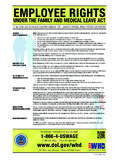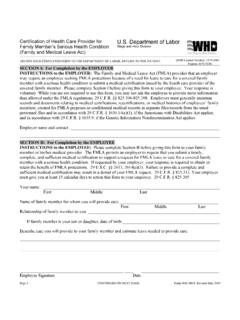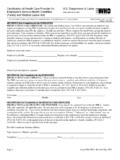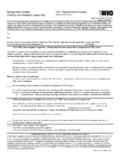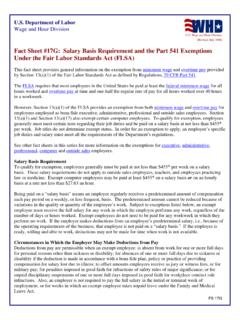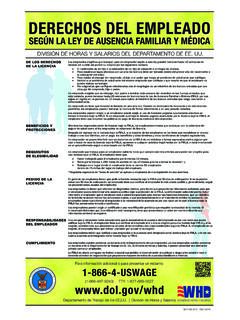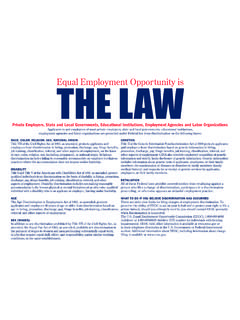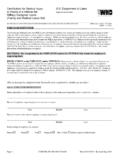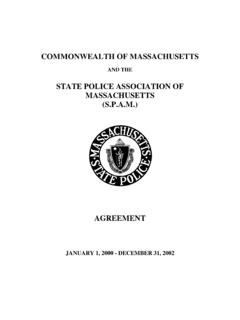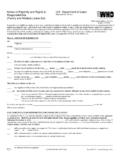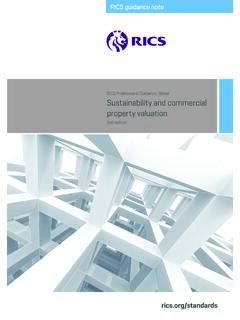Transcription of A Look at 401(k) Plan Fees - DOL
1 A LOOK AT. 401(K) PLAN FEES. This publication has been developed by the Department of Labor, Employee Benefits Security Administration (EBSA). To view this and other EBSA publications, visit the agency's Website. To order publications or speak with a benefits advisor, contact EBSA electronically. Or call toll free: 1-866-444-3272. This material will be made available in alternate format to persons with disabilities upon request: Voice phone: (202) 693-8664. TTY: (202) 501-3911. This booklet constitutes a small entity compliance guide for purposes of the Small Business Regulatory Enforcement Fairness Act of 1996. Introduction More and more employees are investing in their futures through 401(k) plans. Employees who participate in 401(k) plans assume responsibility for their retirement income by contributing part of their salary and, in many instances, by directing their own investments.
2 If you direct your investments, you will need to consider the investment objectives, the risk and return characteristics, and the performance over time of each investment option your plan offers in order to make sound investment decisions. Fees and expenses are one of the factors that will affect your investment returns and impact your retirement income. This booklet answers some common questions about the fees and expenses that your 401(k) plan may pay. It highlights the most common fees and encourages you, as a 401(k) plan participant, to: n Make informed investment decisions;. n Consider fees as one of several factors in your decision making;. n Compare all services received with the total cost; and n Realize that cheaper is not necessarily better.
3 A LOOK AT 401(K) PLAN FEES 1. Keep in mind, however, that this booklet is a simplified explanation of some common 401(k) fees. It is not a legal interpretation of the nation's major retirement benefits protection law, the Employee Retirement Income Security Act (ERISA), or other laws, nor is this information intended to be investment advice. Why consider fees? In a 401(k) plan, your account balance will determine the amount of retirement income you will receive from the plan. While contributions to your account and the earnings on your investments will increase your retirement income, fees and expenses paid by your plan may substantially reduce the growth in your account which will reduce your retirement income. The following example demonstrates how fees and expenses can impact your account.
4 Assume that you are an employee with 35 years until retirement and a current 401(k) account balance of $25,000. If returns on investments in your account over the next 35 years average 7 percent and fees and expenses reduce your average returns by percent, your account balance will grow to $227,000 at retirement, even if there are no further contributions to your account. If fees and expenses are percent, however, your account balance will grow to only $163,000. The 1 percent difference in fees and expenses would reduce your account balance at retirement by 28 percent. In recent years, there has been a dramatic increase in the number of investment options typically offered under 401(k) plans as well as the level and types of services provided to participants.
5 These changes give employees who direct their 401(k) investments greater opportunity than ever before to affect their retirement savings. As a participant, you may welcome the variety of investment options and the additional services, but you may not be aware of their cost. As shown above, the cumulative effect of the fees and expenses on your retirement savings can be substantial. You should know that your employer also must consider the fees and expenses paid by your plan. ERISA requires employers to follow certain rules in managing 401(k) plans. Employers are held to a high standard of care and diligence and must discharge their duties solely in the interest of the plan participants and their beneficiaries. Among other things, this means that employers must: n Establish a prudent process for selecting investment options and service providers.
6 N Ensure that fees paid to service providers and other plan expenses are reasonable in light of the level and quality of services provided;. n Select prudent and adequately diversified investment options;. n Disclose plan, investment, and fee information to participants to make informed decisions about their investment options under the plan; and n Monitor investment options and service providers once selected to make sure they continue to be appropriate choices. What are 401(k) plan fees and who pays for them? If you want to know how fees affect your retirement savings, you need to know about the different types of fees and expenses and the different ways in which they are charged. 2. 401(k) plan fees and expenses generally fall into three categories: Plan administration fees.
7 The day-to-day operation of a 401(k) plan involves expenses for basic and necessary administrative services, such as plan recordkeeping, accounting, legal, and trustee services. A 401(k) plan also may offer a host of additional services, such as telephone voice-response systems, access to customer service representatives, educational seminars, retirement planning software, investment advice, electronic access to plan information, daily valuation , and online transactions. In some instances, administrative service costs are covered by investment fees that are deducted directly from investment returns. Otherwise, if administrative costs are separately charged, they will be borne either by your employer or charged directly against the assets of the plan.
8 When paid directly by the plan, administrative fees are either allocated among participants' individual accounts in proportion to each account balance ( , participants with larger account balances pay more of the allocated expenses) or passed through as a flat fee against each participant's account. Either way, generally the more services provided, the higher the fees. Investment fees. By far the largest component of 401(k) plan fees and expenses is associated with managing plan investments. Fees for investment management and other investment-related services generally are assessed as a percentage of assets invested. You should pay attention to these fees. You pay for them in the form of an indirect charge against your account because they are deducted directly from your investment returns.
9 Your net total return is your return after these fees have been deducted. (See pages 4-6 for more information on investment-related fees.). Individual service fees. In addition to overall administrative expenses, there may be individual service fees associated with optional features offered under a 401(k) plan. Individual service fees are charged separately to the accounts of participants who choose to take advantage of a particular plan feature. For example, individual service fees may be charged to a participant for taking a loan from the plan or for executing participant investment directions. 401(k) plan investments and services may be provided through a variety of arrangements: Employers may directly provide, or separately negotiate with and hire different providers for, some or all of the various services and investment alternatives offered under their 401(k) plans (sometimes referred to as an unbundled arrangement).
10 The expenses of each provider (such as an investment manager, trustee, recordkeeper, or communications firm) are charged separately. In many plans, one provider may offer some or all of the services and investment options for a fee paid to that provider (sometimes referred to as a bundled arrangement). The provider will then pay out of that fee any other service providers that it contracts with to provide the services. Some plans may use an arrangement that combines a single provider for certain services, such as administrative services, with a number of providers for investment options. Regardless of the arrangement used, fees need to be evaluated, keeping in mind the cost of all covered services. A LOOK AT 401(K) PLAN FEES 3. What fees are associated with my investment choices in a 401(k).
